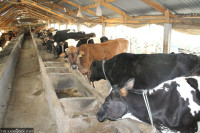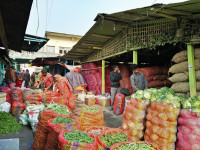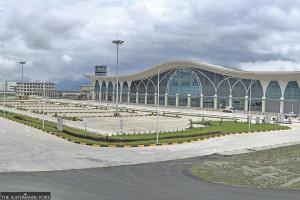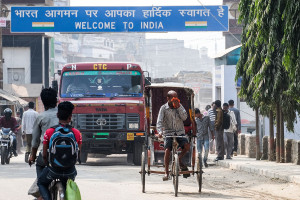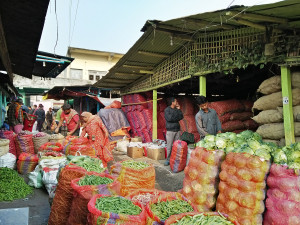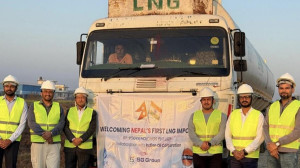Money
Dhaka to import 20MW more from Nepal, taking total to 60MW
Joint meeting gives nod to set up expert panel to assess 683MW Sunkoshi III project and fast-track investment procedures.
Post Report
Bangladesh will import an additional 20 megawatts of electricity from Nepal, taking the total to 60 megawatts.
The agreement was reached during the 7th Nepal-Bangladesh Energy Secretary-level Joint Steering Committee (JSC) meeting held in Dhaka on Thursday. The meeting was co-chaired by Nepal’s Energy Secretary Chiranjeevi Chataut and Farzana Momtaz, secretary at the Ministry of Power, Bangladesh.
The decisions endorsed at the meeting follow the recommendations of the joint task force, which met on November 20 under the leadership of Sandeep Kumar Dev, joint secretary at Nepal’s Ministry of Energy, and KM Ali Reza, additional secretary at Bangladeshi Ministry of Power.
“It has been agreed that Bangladesh will import an additional 20 megawatts of electricity, and Nepal will proceed with the process by obtaining the necessary approvals for exporting,” the Ministry of Energy said in a statement.
The pricing will remain unchanged from the earlier agreement, though Nepal must seek fresh approval for the additional supply. The extra 20 MW export is expected to begin in the next export cycle starting on June 15, 2026.
As the power is transmitted through Indian territory, Nepal will require a new approval from India’s Central Electricity Authority for the additional export to Bangladesh.
Nepal and Bangladesh signed a memorandum of understanding (MoU) on power-sector cooperation on August 10, 2018, establishing the JSC at the secretary level and a Joint Working Group (JWG) at the joint-secretary level to advance cross-border energy initiatives.
The 6th JSC and JWG meetings were held in Kathmandu on October 1, 2024. Following that, a tripartite Power Sales Agreement (PSA) between Nepal Electricity Authority (NEA), Bangladesh Power Development Board (BPDB), and India’s NTPC Vidyut Vyapar Nigam Ltd was signed in Kathmandu on October 3, 2024.
The PSA allows electricity trade during the monsoon months—June 15 to November 15—each year.
Last year, due to uncertainty over approvals, electricity was exported for only 12 hours on November 15, the final day of the permitted window. The next export cycle began on June 15, 2025.
The current transmission route sends power from Nepal to India via the Dhalkebar–Muzaffarpur 400kV line, and onward to Bangladesh through the Berhampur–Bheramara 400kV corridor.
India’s Central Electricity Authority has already approved 18.60MW from Trishuli and 21.40MW from Chilime—40MW in total—for export to Bangladesh until October 2, 2029.
NEA has signed a five-year deal to sell this power at 6.40 US cents per unit. Delivery takes place at the Muzaffarpur substation, with NEA covering technical losses up to that point and Bangladesh bearing downstream transmission losses and trading charges.
Nepal and Bangladesh have also agreed to study the export of electricity through alternative Indian transmission routes to Barapukuria, Panchagarh/Thakurgaon, Bheramara, and Comilla in Bangladesh.
The JSC decided that both countries will jointly push for India’s consent to a trilateral MoU on energy cooperation among Nepal, India, and Bangladesh, according to the statement.
The meeting also endorsed the formation of an expert committee to evaluate the 683MW Sunkoshi III hydropower project and expedite its investment process, including finalising a joint-venture agreement.
Nepal has completed the feasibility study and environment impact assessment (EIA) of the Sunkoshi III. Currently, its licence is with the Nepal government and the new joint venture company will have to acquire a survey licence from the government.
The proposed multipurpose storage project is planned for construction in the Kavrepalanchok and Ramechhap districts of the northeastern province of Bagmati and is designed for electricity generation, flood mitigation, and water supply for irrigation.
The project was first identified in 1985 during master plan studies for water resources development of the Koshi basin by the Japan International Cooperation Agency (JICA). JICA conducted an update to the master plan in 2014.
The project, with an estimated total cost of about US$1.45 billion, is designed to comprise an impervious core wall rock-fill dam in the main river bed, with a maximum dam height of 180 metres.
It is proposed to be sponsored jointly by two Bangladeshi conglomerates, Summit Group and United Group, along with developers from India and Nepal, in cooperation with the governments of Bangladesh and Nepal.
According to Thursday’s statement, the two sides have additionally agreed to sign a new MoU on renewable energy promotion and energy-efficiency cooperation, with Bangladesh set to provide technical support to Nepal in energy testing, electric-vehicle charging, and rooftop solar.
A bilateral capacity-building programme will also be launched, with the first phase to be conducted in Kathmandu for Bangladeshi officials, followed by a programme in Bangladesh for Nepali officials.
According to the Energy Development Roadmap and Action Plan 2023–2035, Nepal aims to generate 28,500MW of electricity, ensure universal energy access, and export up to 15,000MW to neighbouring countries.
At the end of fiscal year 2024–25, Nepal’s total installed generation capacity reached 3,591MW. System peak demand stood at 2,901MW, while national peak demand was 2,409MW. NEA remained a net exporter of power, recording 699 GWh of net exports worth Rs4.5 billion that year.
On July 1, 2025, Nepal recorded a system peak of 2,901MW, of which 2,214MW was consumed domestically, and 687MW was exported to India.




 6.12°C Kathmandu
6.12°C Kathmandu

